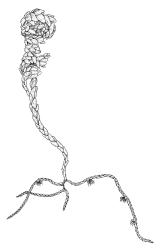Elements in the following description are taken from Buck (1998).
Plants medium-sized, dark or golden-green, epiphytic or rarely on rock, with secondary stems erect and arising from a stoloniferous primary stem. Primary stems creeping and inconspicuous, with reduced and scale-like leaves. Secondary stems erect, often curved when dry, irregularly, pinnately, or bipinnately branched, in cross-section with small and thick-walled cortical cells and no central strand. Leaves of secondary stems and branches similar, appressed when dry, spreading when moist, broadly ovate to lanceolate, rounded to short-acuminate at apex, sometimes asymmetric, concave, not or loosely complanate, often weakly plicate, decurrent, entire throughout or crenulate to serrulate above; upper laminal cells oval, rhombic-elliptic, or rhombic, firm-walled, smooth or unipapillose, similar or sometimes more elongate and ± porose in lower leaf; alar cells numerous, mostly oblate or quadrate, forming a large and opaque group. Costa single, strong or weak, not extending to leaf apex. Paraphyllia lacking or foliose. Pseudoparaphyllia foliose.
Mostly dioicous. Perichaetia large and conspicuous. Setae short, yellow- or red-brown; vaginula densely covered with golden filaments; capsules exserted or immersed, erect, symmetric, ellipsoid to cylindric; annulus none; exothecial cells thin- or firm-walled, mostly oblong or short-rectangular, not collenchymatous; stomata few; operculum conic-rostrate. Peristome double; exostome teeth linear-lanceolate to linear-triangular, usually pale, variably ornamented, with a straight median line on the outer surface, not or scarcely trabeculate on inner surface; endostome reduced or apparently absent. Calyptra cucullate, hairy. Spores ellipsoid or spherical, finely papillose, sometimes variable in size.
Goffinet et al. (2009) included four genera in this family. Of these, only the genus Leptodon occurs in N.Z. A second genus, Forsstroemia, occurs as a rarity in eastern Australia. Forsstroemia differs from Leptodon by having secondary stems that are not curved when dry, acuminate leaf apices, and by its lack of paraphyllia. Leptodon was placed by Brotherus (1925) in a subfamily Leptodontoideae within the family Neckeraceae.
Alsia, of western North America, and Taiwanobryum, of Asia, are also included in the Leptodontaceae by Goffinet et al. (2009). Some of these genera (notably Forsstroemia and Alsia) have been placed in the Leucondontaceae by other authors (Bowers & Crum 1994, p. 667).
According to Buck (1998, p. 155) "the Leptodontaceae derive meaning from more or less frondose secondary stems that are often curved when dry, unicostate leaves with firm- to thick-walled cells, and numerous alar cells, hairy vaginulae, shortly exserted capsules, obliquely rostrate opercula, pale exostome teeth, greatly reduced endostome, and hairy cucullate calyptrae." The family is accepted in the systematic arrangement utilised by the Flora of Australia (McCarthy 2006) and in Smith’s (2004) British Flora.
| Category | Number |
|---|---|
| Indigenous (Non-endemic) | 1 |
| Total | 1 |




